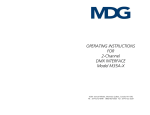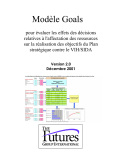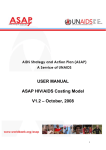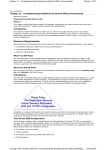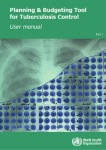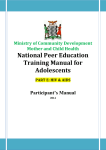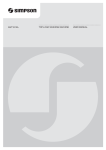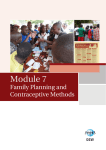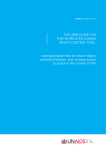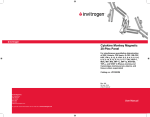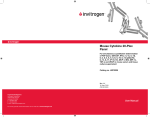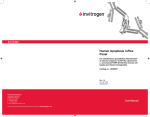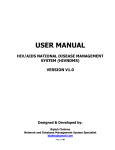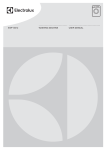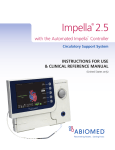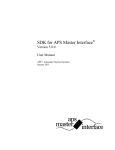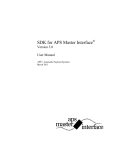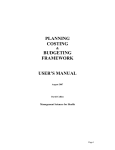Download MDG-Consistent HIV/AIDS Costing Model for Asia and the Pacific
Transcript
User Manual MDG-Consistent HIV/AIDS Costing Model for Asia and the Pacific UNDP HIV/AIDS Practice Team Regional Centre Colombo User Manual MDG-Consistent HIV/AIDS Costing Model for Asia and the Pacific UNDP HIV/AIDS Practice Team Regional Centre Colombo Costing the Response - What is In Scope? 01 HIV Modelling and Costing Tools 01 Using the MDG-Consistent HIV/AIDS Costing Model for Asia and the Pacific (MDG Model) 03 1. Overview of the MDG Model 05 1-1. Worksheet 05 1-2. Structure 05 1-3. Colour Scheme 06 1-4. US Dollar - Local currency conversion 06 1-5. Useful buttons 07 2. Getting started 07 3. Working on the “TOP” Worksheet 09 4. Working on the “Enabling Environment,” “Prevention,” ARV Treatment,” “Care & Support” and “Health Systems” Worksheets 10 4-1 Including/excluding interventions in the total cost calculation 10 4-2. Entering data 11 4-2-1. Opening the data entry section 11 4-2-2. Closing the data entry section 12 4-2-3. Setting the target 12 4-3. Data entry 4-3-1. Unit costs 13 14 4-3-2. Entering costs that cannot be included anywhere or that are shared by multiple interventions 15 5. Reviewing the results 16 (a) Total cost of a particular intervention 16 (b) A total cost for a particular field of response 16 (c) Aggregate total costs 16 6. Areas that need special attention 18 6-1. The Health Systems Worksheet 18 6-2. Condom provisions in the Prevention Worksheet 19 6-3. Unlocking the Worksheet 19 6-4. Saving the work 19 6-5. Customising the MDG Model 19 7. Hands-on Exercise - The best way to get accustomed to the model 22 EXERCISE 1: Basic Moves 22 EXERCISE 2: Enter General Data 23 EXERCISE 3: Enter Intervention Data 23 Annex 1. List of interventions included in the MDG HIV/AIDS Costing Model 30 Annex 2 - Data needs for the MDG Model 32 Annex 3: Reference unit costs 34 User Manual << Contents Estimating Resource Needs Using Tools Costing the Response - What is In Scope? The aim of costing the response is to determine the total cost. This means all interventions and services have a cost, even if they are provided free or even if it is envisage that individuals will bear that cost as an out-of-pocket expense. Both capital and recurrent costs need to be included in total cost estimation (UN Millennium Project 2005b). The total cost needs to be considered when determining and calculating country specific unit costs. Once the response is costed, financing options can then be discussed. The focus is on costing all cash flow components, which then corresponds to projecting the cash flow required to fund the MDGs. However opportunity costs associated with communities investing their time in an intervention is not included (UN Millennium Project 2005b). It is important to understand that total cost estimation is distinct from estimating the cost-effectiveness of interventions or projecting the impact of interventions on the future course of the epidemic such as modelling. HIV Modelling and Costing Tools There are a number of tools available for measuring the impact of and costing the response to HIV/AIDS. These tools have different purposes as mapped out below. Model type Model Name Model purpose Source Epidemiological modelling Asia Epidemic Model (AEM) Allows examination of the impacts of different prevention program choices on the course of the epidemic. http://www.eastwestcenter.org Estimation and Projection Package (EPP) EPP is used to estimate and project adult HIV prevalence from surveillance data in countries with generalised epidemics. http://www.constellafutures.com GOALS It is intended to assist planners in understanding the effects of funding levels and allocation patterns on program impact. http://www.constellafutures.com Funding and goals 1 << Contents MDG-Consistent HIV/AIDS Costing Model for Asia and the Pacific Model type Model Name Model purpose Source Costing INPUT INPUT accompanies the Costing Guidelines for HIV/AIDS Intervention Strategies (UNAIDS and ADB 2004). INPUT calculates the unit costs for common HIV/AIDS interventions using local cost information. Jointly developed by UNAIDS and ADB Resource Needs Model (RNM) The RNM model costs a suite of interventions split into prevention, treatment and care and orphan support. http://www.constellafutures.com Cape Town ARV treatment model The Cape Town model is a detailed treatment model designed to assist planners in estimating costs associated with antiretroviral treatment. Included as a module in the Health Care Costing Model from the UN Millennium Project. ASAP HIV/AIDS Strategy Costing Model (ASAP) The ASAP model, partially based on RNM, creates linkages among costing, national chart of accounts, and national strategic priorities. Developed by ASAP (AIDS Strategy & Action Plan) http://www.worldbank.org/asap The MDG-consistent HIV/ AIDS Costing model (MDG Model) for Asia and the Pacific The MDG Model is built upon RNM and the Cape Town model. It is consistent with the MDG time frame and incorporates HIVspecific MDG targets and interventions for Asia and the Pacific. Developed by UNDP Regional Centre in Colombo in partnership with UNAIDS Regional Support Team for Asia and the Pacific and UNDP MDG Support Team. Some of these tools have objectives broader than costing interventions and may be employed by countries to provide epidemiological inputs to costing exercises, to help prioritise interventions, and to monitor the impact of interventions on country goals and targets. 2 User Manual << Contents Using the MDG-Consistent HIV/AIDS Costing Model for Asia and the Pacific (MDG Model) This section focuses on estimating the total cost of HIV/AIDS responses using the MDG-consistent HIV/ AIDS Costing Model or the MDG Model. The MDG Model is principally built upon the widely-used Resource Needs Model developed by the Futures Group and partially upon the Cape Town ARV Costing Model developed by the University of Cape Town. It has been developed by UNDP Regional Centre in Colombo in partnership with UNAIDS Regional Support Team for Asia and the Pacific and UNDP MDG Support Team (the former UN Millennium Project). The MDG Model was primarily developed to assist the governments in Asia and the Pacific carrying out MDG needs assessment exercises, based upon recommendations from experts from the region that the existing tools had not addressed some of the key issues that are critical to Asia and the Pacific region and some tools had been highly complex and unfriendly to users. The MDG Model is making constant adjustments and improvements based upon feedback from users in the region. While inheriting strengths of the above widely-accepted models, the MDG still offers useful functions, unique features, and high utility. The key features of the MDG Model are as follows: 1. Flexible, MDG-consistent timeline • Users can plan up to or beyond 2015, the MDG target year • Users can define start and end years (up to a range of 10 years), which makes the single model useful for multiple planning horizons (short-, mid- and long-terms) 2. UNAIDS targets for the 2010 universal access goal incorporated • All UNAIDS non-negotiable and other key targets for Asia & Pacific for the 2010 universal access have been incorporated, making the tool consistent with both the 2010 (universal access) and 2015 (MDG 6) goals:. In 2007, the universal access became one of the HIV MDG targets (6B) for Asia and the Pacific, on which countries are required to report. 3. Target, result-based costing • All the interventions in the MDG Model have their own target(s), defined by each country and prominently listed at the top of respective data entry section. The target enables result-based costing and provides a good system of accountability and monitoring the progress towards the target. 4. Expanded Scope • New interventions, which have been shown as important for an effective HIV/AIDS response in Asia and the Pacific, have been added under the heading “Enabling Environment.” Particularly this section addresses human rights, gender and governance dimensions of HIV responses. • Flexible interventions have been included, allowing users to define and add country-specific interventions (e.g., Other Programs to Support PLWHAs) 3 << Contents MDG-Consistent HIV/AIDS Costing Model for Asia and the Pacific • Human resources have been expanded to include more than only physicians; in fact, users can define multiple cadres of human resources as necessary, including managerial and administrative staff • Facility capital and recurrent costs have been added 5. More detail and disaggregation • Major cost components of interventions are clearly defined (e.g., costs of home-based Care include salaries/incentives to providers, salaries of supervisors, transportation equipment or reimbursements to each cadre, etc.) • STIs and OIs are disaggregated and costed by individual infection, as defined by users • Where applicable capital and recurrent costs are differentiated 6. Increased transparency and simplicity • All data and calculations for each major HIV/AIDS category (e.g., prevention, treatment, etc.) occur on a single worksheet that runs top-to-bottom • No hidden assumptions • The Model calculates total capital costs, which are extremely important in expenditure analysis and resource mobilization. 7. User-friendly interface with high utility • Color coding helps users easily differentiate between input and output cells • Unit cost inputs have been reorganized for conceptual ease (e.g., cost per outreach worker visit is disaggregated into its constituent inputs that may be more readily understood by users) • User provides population data directly so that that model can be used at sub- or supra-national levels as necessary • Users can change unit costs and coverage scale-up paths each year • It can explicitly include health infrastructure, and human resource costs. • Users can restore the original formula and conditions with a push of a button “RESET.” • Users can refer to proxy data and reference information to assist data entry. • Projected inflation can be easily accommodated 8. Synchronised with an MDG-consistent HIV/AIDS needs assessment user guide • The MDG Model can be used in tandem with the MDG-consistent HIV/AIDS needs assessment user guide. As needs assessment and prioritization have vital implications on the total cost of intervention, synchronization between the needs assessment user guide and the MDG Model provides a principled approach to the needs assessment and costing exercises. 4 User Manual << Contents 1. Overview of the MDG Model: The MDG model is an Excel-based tool, with imbedded formulas. The tool calculates costs per intervention, sub totals costs at the level of the following five categories or “Response Fields”: Enabling Environment, Prevention, ARV Treatment, Care and Support, and Health Systems. It also calculates an annual grand total for the HIV/AIDS response. It has a dynamic 10-year time period that users can specify start and end years for. The following section describes the basic features and functions of the MDG Model. 1-1. Worksheet The MDG model has 7 active worksheets (working areas) as shown below: (1) TOP, (2) Enabling Environment, (3) Prevention, (4) ARV Treatment, (5) Care & Support, (6) Health Systems, and (7) Cost Summary. Each tab has a different colour for easy identification: The worksheets with gray tabs such as “TP” and “EE” as shown above are not for use (and should not be altered or deleted. See 6-4 for more details). 1-2. Structure Each worksheet for specific intervention area (Enabling Environment, Prevention, ARV Treatment, Care & Support and Health Systems) is consisted of 4 sections. List of interventions Data entry section Cost summary section Graphical representations of the costing results 5 << Contents MDG-Consistent HIV/AIDS Costing Model for Asia and the Pacific 1-3. Colour Scheme The MDG model uses the following cell colour scheme to visually guide users for easy data entry and analysis. 1-4. US Dollar - Local Currency Conversion Users can work either with the US dollar or the local currency of choice. The default setting is US dollar, but it can be changed to the local currency at any time by selecting [Currency Converter] - [Convert] located at the menu bar. Note: Currency Converter does not appear unless Macros are enabled (See 2: Getting Started). This will translate all USD figures in the model into the local currency across all the worksheets as per the US exchange rate defined in the TOP worksheet. If you want to go back to USD, simply select [Currency Converter] - [US dollar]. The currency unit can be converted between the US$ and the local currency at any time. When conversion is performed, all the financial values across all the worksheets in the model will be converted into the currency of choice. It is a useful function, as it allows users to work with the local currency unit while the cost can be converted into the US$ for resource mobilisation purposes. Additionally, the conversion function allows only one currency unit to be displayed as opposed to two different currencies as seen in some other costing models, which can sometimes be quite confusing. In case of Excel 2007: • Click on the “Add-Inns” tab in the menu bar (see below) and the [Currency Converter] will appear. 6 User Manual << Contents 1-5. Useful buttons The MDG model introduces useful functions to facilitate the data entry work. You will see the following buttons located at certain places in the model: • “RESET” Button: This allows the restoration of the original cell formulas/values in certain sections. This is helpful when formulas contained in certain cells are accidentally deleted or when users wish to perform sensitivity analyses by placing different sets of values to assess their impact on outputs such as the total cost or the level of coverage. • “PROX” Button: The MDG model or any costing model requires extensive sets of data in order to perform calculations. However, sometimes some data are simply not available in a country. To help users deal with such a situation, the model gives an onsite reference to proxy indicators based on established data. • “REF” Button: It gives onsite reference information on certain topics. 2. Getting started • Open an Excel file with a name “MDG-consistent HIV Costing Tool” • You will be prompted with security warning. • Select “Enable Macros” • If you do not see this Security Warning, select [Tools] (on the menu bar at the top) - [Macro] [Security]. You will see the following window. 7 << Contents MDG-Consistent HIV/AIDS Costing Model for Asia and the Pacific • Ensure “Medium” is selected. • Once “Medium” is selected, close and re-open the file. The Security Warning Prompt as shown above should appear this time. • NOTE: The MDG model will not function properly without Macros enabled. In case of Excel 2007: • Open an Excel file with a name “MDG-consistent HIV Costing Tool” • Press “Options” in the Security Warning bar located under the menu bar. • You will be prompted with the Security Alert – Macro window. • Select “Enable this content” and press OK. 8 User Manual << Contents 3. Working on the “TOP” Worksheet The TOP Worksheet is where basic information such as currency, start & end years, and demographic information, is entered. • Enter basic information into the yellow cells (1. country, 2. currency unit, 3.US exchange rate, 4. Start Year, 5. End Year, 6. population in Start Year, 7. annual population growth rate, 8. number of PLHIV in Start Year and its annual growth rate). • Start & End Years can be a maximum of 10 years apart from each other. For example, if the Start Year is 2008, the End Year has to be 2017 or earlier. It is recommended that the 10-year interval be used. • As mentioned above, figures in the orange cells can be changed manually. • For instance, if the annual PLHIV growth rate is expected to grow from 6% in 2008 to 8% in 2010 & onwards in the above example, simply left single click the target cell (shown in a red box above) and type “8” and hit Enter. The following years will be automatically changed to 8%. • Note that there is a RESET button to clear all the cells in the section on # of PLHIV. 9 << Contents MDG-Consistent HIV/AIDS Costing Model for Asia and the Pacific 4. Working on the “Enabling Environment,” “Prevention,” ARV Treatment,” “Care & Support” and “Health Systems” Worksheets These Worksheets share the common styles and procedures. The following provides information that is applicable to all these Worksheets. Issues specific to a particular worksheet or intervention will be addressed separately. 4-1 Including/excluding interventions in the total cost calculation As outlined in Part 3 of this user guide, country teams need to identify interventions that are relevant for their epidemic which will allow them to achieve their HIV/AIDS Millennium Development Goal and target. The MDG model offers flexibility in including relevant interventions for each country’s response to the epidemic. Each worksheet has default interventions listed at the top (See the list of default interventions in Annex 1). All the listed interventions are “selected” (a tick in the box as below) as default, which means costs of these interventions will be included in the total cost. However, you can also exclude particular interventions as shown below by ticking off a box. This function also allows users to assess the financial impact of particular interventions on the total cost by checking the box on and off. If an intervention is not relevant simply leave the check box. Also, users can change the name of interventions. To change the name, right click on the cell containing the intervention you wish to change. This will show the name of the intervention in the formula box (see below) in which you can enter a new name. New name can be entered here 10 User Manual << Contents 4-2. Entering data 4-2-1. Opening the data entry section At default, all data entry sections are “closed,” showing only the name of intervention and its target (s). This setting makes it easier to find a particular intervention among many and to keep the worksheet organised. There are two ways to “open” the data entry section. (1) Opening the data entry section for a particular intervention(s) You can open only a selected intervention (s) by clicking a plus (+) sign located on the left side of the worksheet. For example, to open the data entry section for an intervention #1 in the example below, clicking on the plus (+) sign located at the left side of Row# 155 opens the data entry section for the intervention #1. Data entry section for intervention #1 “closed” Data entry section for intervention #1 “open” You can open the only section (s) you are working on so that the worksheet stays organised, less confusing, and easier to navigate. (2) Opening all the data entry section for all the interventions at one go You can open the data entry section for all the interventions at one go, click on “2” located at the upper left corner of Excel. 1 – Close all the data entry sections 2 – Open all the data entry sections 11 << Contents MDG-Consistent HIV/AIDS Costing Model for Asia and the Pacific 4-2-2. Closing the data entry section The data entry section can be closed by either clicking a minus (-) sign located on the left side of the row number or by clicking a “1” at the upper left corner of Excel. 4-2-3. Setting the target One of the unique features of the MDG model is that each intervention is accompanied by its specific target(s) defined by users. These targets are defined by each country and enables results-based costing with a system of accountability and monitoring of the progress. The default targets, which include UNAIDS non-negotiable targets for universal access to prevention, treatment and care by 2010 (which were officially incorporated into MDG targets for Asia and the Pacific in 2007), can be easily redefined by double-clicking on the cell that contains the target. In some interventions, these targets are then entered (manually) into the model as below. First you enter the Target Year (“2010” in the above example), followed by a coverage level of the current or Start Year (“50%”) and that of the Target Year (“80%”). The model then assumes a linear increase between the start and the end year and automatically generates a coverage level to be achieved in each year in order to achieve the target (see below). The coverage level after that target year will sustain the target level. However, the coverage levels can be changed manually (as they are in orange cells), allowing users to frontload or backload efforts and to make adjustments midway depending on the progress. The model assumes a linear increase in the coverage level Years after the target year maintain the target coverage level at default 12 User Manual << Contents 4-3. Data entry Data entry is straight forward in the MDG model in most cases. Users simply enter required data in yellow cells. Some sections require all yellow cells to be filled with data – missing data will produce either no or incorrect calculations. In an example below, the user enters interventions that are considered necessary to achieve the target. This is followed by the annual frequency of each intervention and its unit cost that are entered into appropriate yellow cells. In some other cases, interventions are pre-determined such as HIV prevention among sex workers, followed by the coverage level and unit cost. In the below example, an intervention “Commission baseline studies” will take place once in 2007 at the cost of $3000. An intervention “Dissemination workshops” will take place 3 times in 2008 at the cost of $5000 per workshop. Note that the unit cost is always entered into the “2007” or ‘Target Year’ column. In the case of “Commission drafting of a bill,” the unit cost of $2000 is entered into the 2007 column despite the fact that the activity will take place only in 2008. However, the $2000 in the 2007 column is shown faded, indicating that it will not be calculated. Enter activities that are considered necessary to achieve the target Dissemination workshops will happen 3 times in 2008 The unit cost must always be entered into yellow cells in this first (“Start Year”) column. As mentioned previously, the MDG model has a useful “RESET” button to clear a particular field and restore its original state. This could be a very powerful function, which allows an easy entry of different figures to assess their impact on the cost without manually erasing each cell for a different figure. 13 << Contents MDG-Consistent HIV/AIDS Costing Model for Asia and the Pacific 4-3-1. Unit costs Before entering unit costs, users need to decide what currency to use. The model uses the US Dollar as a default currency unit. If a local currency, as defined in the Top worksheet, is preferred, you need to change the working currency unit from US$ to a local currency. The working currency unit can be changed from US$ to a local currency by selecting [Currency Converter] - [Convert] as shown in 1-4 above. Note: the “Currency Converter” menu does not appear if macros are not enabled. Some notes on the unit cost: • The unit cost is the total financial value of the intervention. • As a preference use unit cost data that is country specific, only referencing globally defined figures as a guideline (The INPUT model is designed to estimate the unit cost of various HIV interventions). Locally developed unit costs will be more accurate, provide a better understanding of intervention costs, and their associated implications, and thus greater ownership of the costing outputs (Alban and EASE International n.d.). • Ensure the unit cost equates to the intervention. For example, if the intervention is to provide harm reduction for injecting drug users, including pharmacotherapy, needle exchange programs, condom provision, shelter and life building skills, ensure that the unit cost includes all of those elements, not just pharmacotherapy and needle exchange. • Capital and human resource costs. (The INPUT model and Costing Guidelines for HIV/AIDS interventions strategies illustrates how to include these costs in the unit cost (UNAIDS and ADB 2004).) Alternatively the proportion of infrastructure and human resource unit costs attributable to HIV can be entered on the Health Systems worksheets as discussed below. • Ensure that the unit cost is reflective of the scope and coverage of the intervention. Questions such as follows need to be examined when determining the appropriate unit cost: - Does the unit cost vary between rural and urban populations? - Does the unit cost vary for interventions targeting youths in school to those out of school? • The model assumes unit costs are constant across the time period. However, this can be changed to reflect the impact of marginal costs over time and as coverage increases (UN Millennium Project 2005b). Note that the cell colour for unit costs are orange, which means users can change values. • Country teams need to develop and identify unit costs specific for their country and chosen interventions. It is envisaged that available country specific resources and involvement of key stakeholders conducting interventions on the ground will facilitate the process of collecting country specific data. • Identifying unit costs is vitally importance as they provide concrete criteria and key information (e.g. operational efficiency & effectiveness) to help prioritise interventions within limited financial means as well as help project future costs of particular interventions. • However, when there are no local unit costs available, users can refer to proxy indicators as a reference, which can be found in Annex 3. Some proxy indicators are also available in the model where a “prox” button is located. 14 User Manual << Contents 4-3-2. Entering costs that cannot be included anywhere or that are shared by multiple interventions Sometimes there are costs that are not specific to a particular intervention or are better to be calculated independently. Examples include vehicles and other capital investments that are used for multiple interventions. The MDG model provides a space to accommodate such cross-cutting costs. At the end of the Cost Summary section in each Worksheet, there are yellow cells that can accommodate such costs. Double-click on a cell “Other” and enter the name of the cost. If it is a capital cost, a small box needs to be ticked so that it will be properly reflected as such in the Cost Summary Worksheet. Additionally, this space also provides a flexibility of plugging in the total cost of a particular intervention or response field that is already available or generated using different tools. For example, if a country wishes to calculate the total cost of ARV medicines with a high level of details such as combination regimen-specific estimates, which is not available in the MDG model, it can be performed by such a tool as the Cape Town Model. Then the total amount calculated can simply be copied and pasted in this space, while keeping all the other areas unused. 15 << Contents MDG-Consistent HIV/AIDS Costing Model for Asia and the Pacific 5. Reviewing the results After entering appropriate data, costs can be viewed at 3 different levels: (a) intervention, (b) response field (e.g. prevention), and (c) aggregate total. (a) Total cost of a particular intervention A total cost of a particular intervention is shown at the bottom of the data entry section of each intervention, in the Cost Summary section towards the end of the Worksheet as well as in the Cost Summary Worksheet. (b) A total cost for a particular field of response Total annual costs for a particular field of response such as enabling environment, prevention and ARV treatment is shown in the Cost Summary section as below as well as in the Cost Summary Worksheet. Total annual cost for ARV treatment for 2008 (c) Aggregate total costs The Cost Summary Worksheet gives a comprehensive summary of all costs, by response field, intervention, year, and aggregate total. It also provides information on annual capital cost as well as annual per capita cost. These disaggregated figures can be useful, particularly in budget negotiation, resource mobilisation and donor reporting purposes. 16 User Manual << Contents Additionally, users can adjust the total cost figures according to projected inflation rates to produce as realistic figures as possible. Inflation rates can be manually entered into the yellow cell as below. As mentioned previously, the currency unit can be changed at any time using the Currency Converter to review figures both in the US Dollars and the local currency of choice. The model also produces graphs as a visual aid to understanding the projected trends up to the End Year and proportion of costs by response field. (Note that the graph “HIV/AIDS Costs By Year” represents figures without annual inflation.) These graphs can be useful materials, which can be used for a presentation to donors and stakeholders. 17 << Contents MDG-Consistent HIV/AIDS Costing Model for Asia and the Pacific 6. Areas that need special attention 6-1. The Health Systems Worksheet As a component of the cost of HIV/AIDS medical interventions will include the cost of the health facilities and human resources associated with delivery of that intervention, users need to decide on how to incorporate those costs. There are two possible ways these costs can be incorporated: 1) a component included in the unit cost of the medical intervention, or 2) by entering health facility and human resource details, and then specifying the HIV/AIDS proportion of those construction, maintenance and human resource cost details on the Health Systems Worksheet. If the latter is chosen, users need to take the following steps: a. Check the boxes in the default intervention list to include the cost of Health Systems in total cost calculations. At default, these boxes are NOT checked. Ensure that these boxes are checked before entering data b. Specify: • the number of health facilities, • unit costs for construction, equipment, operations and maintenance and rehabilitation of facilities, • the number of health staff, • staffing costs, and • attribution of these costs to HIV/AIDS as shown in an example below: Users specify the percentage of operations and maintenance costs attributable to HIV/AIDS. 18 User Manual << Contents 6-2. Condom provisions in the Prevention Worksheet Caution needs to be exercised when estimating the total cost of condoms distributed. As condom provision is found in multiple interventions, there is a risk of double-counting and overestimation. To minimise this overestimation risk, the model automatically adjusts the total costs of condom provision. The model subtracts the sum of costs of condom provision (male condom only) in all relevant prevention interventions (other than that of 10. Condom Provision) from the total cost of prevention interventions. In this way, the total cost for Prevention can exclude double-counting of condom provision costs. This adjustment is performed at the Cost Summary section in the Prevention Worksheet: The amount of double-counted costs for condom provision is subtracted. 6-3. Unlocking the Worksheet All the Worksheets are protected or “locked” except for data entry cells, in order to prevent accidental deletion of cells, texts and other important information. However, users can unprotect or “unlock” the worksheet to make specific changes in default texts, settings or formulas. To unprotect a particular worksheet, select [Tool] – [Protect] – [Unprotect Sheet] and then changes can be made in any place and any settings under that particular worksheet. In case of Excel 2007, select [Review] – [Unprotect Sheet] as shown below. 6-4. Saving the work It is recommended that, once data are entered, the work be saved as a different file name to keep the original file intact. Although the RESET function can restore certain cells to the original state, keeping the original file is always a recommended practice. 6-5. Customising the MDG Model As the MDG Model is an Excel-based tool, it offers the flexibility of customisation to best suit local circumstances. However, caution needs to be exercised, particularly in adding/deleting/moving rows/columns/ cells, as there is a currency conversion macro (an embedded formula) that is aligned specifically with the default cell settings. When changes are made and original cell locations are shifted, the currency conversion macro needs to be adjusted accordingly. To do so, first open the macro by selecting [Tool] – [Macro] – [Macros]. 19 << Contents MDG-Consistent HIV/AIDS Costing Model for Asia and the Pacific You will be prompted with a Macro window: Select “convert” - [Edit] to open an editor for a macro that calculates currency conversion: The red box above shows a place where ranges of cells to be calculated for currency conversion are defined and this is where adjustments need to be made following cell location changes. 20 User Manual << Contents Each line of formula contains a cell range to be effected by the currency conversion function. For example, the following formula shows that the first cell range to be effected is between C47 to L55 in the Enabling Environment Worksheet. RangeArr(1) = “’Enabling Environment’!C47:L55,’Enabling Environment’!C87:L95, Cell range C47 to L55 – all the cells within this range are subject to currency conversion calculations Therefore, changes in the location of cells that are subject to currency conversion need to be reflected in the cell range in the currency conversion macro. If, for example, a new raw is inserted between rows #46 and #47 in the above example, it will affect the location of all the cells after row #47. In this case, the entire cell ranges for Enabling Environment in the macro need to be adjusted accordingly to capture the new cell range. You can see that there are five blocks of formulas, which correspond to the 5 Worksheets/response fields of the model. The adjustments such as above need to be made only within the block of a particular Worksheet where changes have occurred. In the example above, changes in the cell range need to be made only in the block of formulas for Enabling Environment. After all the changes have been made, the entire worksheet needs to be copied and pasted into its corresponding “reserve” worksheet. Each Worksheet has its own reserve worksheet such as TP, EE, P, T, which stand for “ToP,” “Enabling Environment, “ “Prevention,” and “Treatment,” respectively. These reserve worksheets are used to restore the original state of specific cells when the “RESET” function is used. Therefore, when changes are made in the structure of a Worksheet, they need to be reflected in its reserve sheet. 21 << Contents MDG-Consistent HIV/AIDS Costing Model for Asia and the Pacific 7. Hands-on Exercise - The best way to get accustomed to the model Often the best way to get started and familiarised with the tool is by actually using it. There is an introductory exercise below, which walks you through all basic functions and features of the MDG model. It is highly recommended that users wishing to use this model go through the exercise before actually working on the model. EXERCISE 1: Basic Moves 1-1. Open a file “MDG-Consistent HIV/AIDS Costing Tool ver.exl” on the Desktop Click “Enable Macro” If you do not see this, please do the following: (1) “Tool” - >“Option”- > “Security” -> “Macro Security” -> Check “Medium” (2) Close and Re-start Excel 1-2. Open the following worksheets by clicking a corresponding tab and scroll up and down to skim through the entire worksheet • Enabling Environment • Prevention • ARV Treatment • Care & Support • Summary Cost 1-3. Open the “Enabling Environment” worksheet • Unfold all the intervention sections by clicking the “2” button located at the upper left corner of the worksheet • Scroll down to see if all the sections are fully open • Fold all the intervention sections by clicking the “1” button • Unfold the first intervention “Review/develop/amend intellectual property laws to allow the application of TRIPS safeguards and flexibilities” by clicking the “+” button at the left side of the target (row 58). • Fold the first intervention section by clicking the “-“ button (row 58) • Again, click the + button to open the first intervention section. Go to the unit cost section to check the currency unit is US$. 22 User Manual << Contents EXERCISE 2: Enter General Data • Open the “Top” worksheet • Enter the required values on the “Top” worksheet based on the figures provided below • Press “Tab” after each data entry • Before you enter the number of people living with HIV, press RESET to clear the field • You do not need to enter “%” when you enter the percentage figures. • Please note that all figures mentioned in the document are for exercise purposes only. Item Value Country Gaikoku Local Currency Unit G$ US Exchange rate 75 Costing years Start: 2008 End: 2017 Population 25,000,000 Annual population growth rate (%) 2.5 Estimated number of people living with HIV 25,000 Annual PLHIV growth rate (%) 3 (2008-11) 5 (2012-17) EXERCISE 3: Enter Intervention Data 3-1. ENABLING ENVIRONMENT (A) • Open the Enabling Environment worksheet • Open the intervention section #1 “Review/develop/amend intellectual property laws to allow the application of TRIPS safeguards and flexibilities” by pressing the “+”button left to Cell 58. Let us assume your government has decided the following as in Table 3-a: • Reflect the target year in the target cell by double-clicking B19 and make the change • Enter the number of intervention based on the information above Add “Media Campaign” by double clicking on B26 and replacing “Other 1” with “Media Campaign”. 23 << Contents MDG-Consistent HIV/AIDS Costing Model for Asia and the Pacific Table 3-a Item Value Unit cost Cell Target year 2011 - Activities to carry out: - - 1. baseline study Conducted once in 2008 USD 1000 C47 2. Drafting a bill Conducted once in 2009 USD 2000 C48 3. Dissemination workshops Conducted once in 2008 & 2009 USD 3000 C49 4. National consultative meetings Conducted twice a year in 2008, 9, 10 & 11 USD 5000 C50 Add: 5. Media Campaign Conducted once in 2010 USD 10,000 C51 • Enter the unit cost for the corresponding activity. All the unit costs are to be entered in the yellow cells in the “C” column. • You should have the following cost figures: $14,000 (2008), $15,000 (2009), $20,000 (2010), $10,000 (2011) • Now, select “Convert” in the “Currency Converter” to translate the USD into the local currency “G$” as defined in the TOP Worksheet. • Select “USD” in the “Currency Converter” to return back to G$ • Scroll down to the Cost Summary section to see if the cost of the newly-entered intervention is reflected in the table as well as in the graphs. • Close the section either by pressing the “-“ button next to Cell 58 or by pressing “1” at the upper left corner. (B) Open the section #12 “Conduct research and/or strengthen surveillance system to collect epidemiological data related to HIV and provide evidence for optimal decision-making and resource prioritisation” by clicking the “+” button next to Cell 660. Let us assume your government has decided the following as in Table 3-b: • Enter the figures based on the table 3-b below. Note there are 2 types of unit costs: Recurrent and Capital, which has a separate section each. • For the unit cost for “Strengthen and maintain a surveillance system,” enter USD 10,000 in Cell D611, USD2,000 in Cell E611 and USD 20,000 in Cell D638. • You should have the following cost figures for this intervention: $152,000 (2009), $24,000 (2010), $14,000 (2011), $6,4000 (2012), $14,000 (2013&14), and $6000 (2014 &15) • Close all the sections by pressing the “1” button at the upper left corner • Scroll down to the Cost Summary section to see if the cost of the newly-entered intervention is reflected in the table as well as in the graphs. 24 User Manual << Contents Table 3-b Item Value Unit Cost (Recurrent) Unit cost (Capital) Target year 2010 - Activities to carry out: - - Needs assessment studies Conducted once in 2009 USD 5000 Develop guidelines Conducted once in 2009 USD 3000 Develop database systems Conducted once in 2009 & 10 USD 10000 Training of public health officials on surveillance Conducted twice a year from 2009 to 2015 USD 2000 Conduct BSS studies among general and vulnerable populations Conducted once in 2009 and 2012 USD 50000 Strengthen and maintain a surveillance system Conducted every year from 2009 to 2015 USD 10000 (2009) and USD 2000 for the rest USD 50000 (2009 only) Cell D635 USD 20000 (2009 only) Cell D 638 • Also, press the “COST SUMMARY” worksheet to see how figures are listed in the table. • Go back to the “ENABLING ENVIRONMENT” worksheet • Go to the list of interventions and deselect #12 pressing the box in Cell A13. • Scroll down to the table and graph at the bottom as well as to the COST SUMMARY worksheet to see the change (C) Adding miscellaneous expenses You can add expenses that cannot be included in any section. • Scroll down to the Cost Summary section in Enabling Environment. • Double click on Cell B929 and type “4x4 Vehicle” • Enter USD 30,000 in Cell C929 • As this is a capital cost, tick the box in Cell B929 • Go to the “COST SUMMARY” worksheet to see how this expense is reflected 25 << Contents MDG-Consistent HIV/AIDS Costing Model for Asia and the Pacific 3-2. PREVENTION Go to the PREVENTION worksheet. Enter the data based on the information provided below: 3-2-1: Prevention of HIV among sex workers (#1) * The default targets (1) and (2) are non-negotiable targets for 2010 Universal Access suggested by UNAIDS Regional Support Team for Asia Pacific Item Cell Value Number of sex workers C28 23,000 Annual growth rate (%) C29 3 Number of commercial sex acts per sex worker per year C34 Get a proxy figure by pressing “PROX” Condom wastage (%) C35 1 Number of sex workers contacted per counsellor per year C36 200 Target year 2010 % sex workers contacted per counsellor per year C41 D41 Start: 10 Target: 80 % using condoms among those reached by intervention C42 D42 Start: 25 Target: 60 % using condoms among those not reached by intervention C43 D43 Start: 10 Target: 50 % of all condoms that are female condoms C44 D44 Start: 0 Target: 5 Unit cost per counsellor per year D53 USD 1000 Unit cost per male condom distributed D54 USD 0.3 Unit cost per female condom distributed D55 USD 1 • Close the section by pressing the “-“ button or “1”. 26 User Manual << Contents 3-2-2: Workplace Programme (#9) Item Cell Value Labour force participation rate – Male (%) C351 80 Labour force participation rate – Female (%) C352 40 Number of sex acts with regular partners per year C355 60 Adult male population D359 12,000,000 Adult female population D360 11,000,000 Target year 2015 % workforce receiving peer education/intervention C368 D368 Start: 5 Target: 50 % workforce receiving STI treatment C369 D369 Start: 50 Target: 80 % workforce receiving condoms C370 D370 Start: 10 Target: 50 Unit cost of person in employment reached (peer education/intervention) D379 USD 0.5 Unit cost of STI treated in workplace D380 USD 1 Unit cost per male condom distributed D381 USD 0.1 • When done, check the cost summary and graphs to see if the figures are properly reflected. • Then, tick off a box next to “9. Workplace Programme” in the list of interventions at the upper left corner of the worksheet. • Scroll down to the cost summary section and check if the cost for Workplace Programme has now been removed. 3-3. ARV TREATMENT Enter the data based on the information provided below. Note the change in values in the midway for some items. 27 << Contents MDG-Consistent HIV/AIDS Costing Model for Asia and the Pacific 3-3-1. Antiretroviral Therapy *The default target is a non-negotiable targets for 2010 Universal Access suggested by UNAIDS Regional Support Team for Asia Pacific Item Value Adults in need of ART as % of total PLHIV 10 Children in need of ART as % of total PLHIV 0.1 Target year 2010 % Adults in need of ART receiving ART Start: 7 Target: 75 % Children in need of ART receiving ART Start: 5 Target: 75 % Adults on first-line ARV medicines 99 (2008-12) 95 (2013-) % Adults on second-line ARV medicines 0.1 (2008-12) 2 (2013-) % Adults failing therapy 0.9 (2008-12) 3 (2013-) % Children on first-line ARV medicines 98 (2008-12) 90 (2013-) % Children on second-line ARV medicines 0.2 (2008-12) 5 (2013-) % Children failing therapy 1.8 (2008-12) 5 (2013-) Cost of adult first-line ART (per person per year) USD 138 (2008-10) USD 100 (2011-) Cost of adult second-line ART (per person per year) USD 1285 (2008-10) USD 650 (2011-) Cost of adult failing therapy (per person per year) USD 3000 Cost of child first-line ART (per person per year) USD 138 (2008-10) USD 100 (2011-) Cost of child second-line ART (per person per year) USD 1500 (2008-10) USD 800 (2011-) Cost of child failing therapy (per person per year) USD 4000 • When done, check the cost summary and graphs at the lower part of the worksheet to see if the figures are properly reflected. • Also, check the Cost Summary worksheet (the Black tab) to see if the figures from the ARV treatment section are properly reflected. 28 User Manual << Contents 3-4. Cost Summary • Select the Cost Summary worksheet (Black tab at the bottom of the screen) • Check to see all the figures are reflected and graphed • See the graphs as to the proportion of the cost for each intervention area in light of the total cost • See the per-capita cost and capital cost across the years 3-5. Finish • Go back to all the sections that you have entered data. Clear all the cells by pressing the “RESET” button 29 << Contents MDG-Consistent HIV/AIDS Costing Model for Asia and the Pacific Annex 1. List of interventions included in the MDG HIV/AIDS Costing Model INTERVENTIONS TARGETS / INDICATORS ENABLING ENVIRONMENT Review/develop/amend intellectual property laws to allow the application of TRIPS safeguards and flexibilities Presence of IP laws that will enable access to affordable generic HIV medicines by 20XX (target year defined by each country) Review/develop/amend legislations that protect women’s rights to property and inheritance Presence of legislations that protect women’s rights to property and inheritance by 20XX Review/develop/amend legislations that discriminate against vulnerable populations including women, sex workers and MSM Presence of legislations that de-criminalise sex workers and MSM and that promote and protect the rights of women by 20XX Review/develop/amend legislations that enable harm reduction activities for IDUs including needle exchange and drug substitutions Presence of legislations that enable harm reduction activities for IDUs by 20XX Provide affordable legal support for PLHIV and vulnerable groups % of vulnerable population having access to affordable legal support Conduct research to collect epidemiological data related to HIV and provide evidence for optimal decision-making and resource prioritisation Presence of reliable, recent, and longitudinal data related to the epidemic including behavior and knowledge for planning, monitoring and evaluation Monitor human rights violations against people living with HIV and their family members Presence of monitoring and redress systems of human rights violations against PLHIV by 20XX Implement programmes to reduce stigma and discrimination Reduction in stigma and discrimination against the baseline Support the empowerment and capacity building of HIV positive people’s networks for their meaningful participation in the response Presence of positive people’s networks organisationally and financially empowered to advocate for their rights and provide services by 20XX Mobilise resources Resources (domestic and international) fully meet estimated needs by 2008 or increase resources by three times from the 2005 level PREVENTION Ensure HIV testing and counseling are available and affordable By 2015, affordable HIV testing and appropriate counseling are offered at all clinics for STI, TB, and antenatal care Implement programmes for prevention of parent-to-child transmission (PPTCT) 80% of pregnant women accessing services related to PPTCT Develop and implement programs for young people: HIV prevention programmes for in-school and out-of-school children - 100% of young people having access to reliable information about the epidemic and how to protect themselves - % primary students with teachers trained in HIV/AIDS - % secondary students with teachers trained in HIV/AIDS - % out of school youth reached 30 User Manual << Contents Develop and implement workplace HIV/AIDS policies and programmes in partnership with the business sector - Presence of national workplace HIV/AIDS policies - % of industries having workplace HIV/AIDS policies - % of workforce reached by prevention programmes - % workforce receiving peer education - % workforce receiving STI treatment - % workforce receiving condoms Develop and implement comprehensive HIV programmes for both brothel- and nobrothel based sex workers and their clients - 80 % of sex workers reached by intervention by 2015 - 60 % of sex workers reached by intervention using condoms - % using condoms among those not reached by intervention - % of all condoms that are female condoms Develop and implement comprehensive HIV programmes for IDUs - 80% of IDUs receive harm reduction interventions (syringe and needle exchange and drug substitution) and counseling and testing - 60% of IDU use condoms Provide VCT services % of VCT needs fulfilled Ensure blood safety % of transfusion blood screened for HIV Strengthen STI treatment - At least 75% of people with STIs are appropriately diagnosed, counseled and treated by 2015 - Decline of STI compared to the 2005 figure TREATMENT Provide antiretroviral therapy (ART) Equitable and sustainable access to ART for at least 80% of those in need (both children and adult) Ensure treatment monitoring systems are in place % of those on ART receiving tests for CD4 count, viral load, and full blood count CARE & SUPPORT 31 Treat OIs and other HIV-related illnesses % of positive people with OI are treated Provide nutritional information and support to people living with HIV Percentage of positive people given nutritional information and support (% target to be set by each country) Provide home-based care % of PLHIV who desire home-based care have access to it Provide palliative care % of PLHIV in need of palliative care have access to it Provide support to orphans and vulnerable children (OVC) % of OVC receiving a basic external support package (e.g. school fees, shelter and food) Provide economic support to households headed by women living with HIV, including cash transfer, vocational training, micro-credit schemes % of households headed by women living with HIV receiving economic support Provide support to families of people living with HIV % of families or positive people provided with counseling, support, including facilities and parents participation in MTCT plus << Contents MDG-Consistent HIV/AIDS Costing Model for Asia and the Pacific Annex 2 - Data needs for the MDG Model Depending on which interventions your country decides to pursue, the following indicates the data input needs for the HIV/AIDS resource needs model. Enabling Environment Unit costs for studies commissioned on changing legislation, monitoring human rights, stigma and discrimination and advocacy programs Unit costs for consultation meetings on changing legislation, monitoring human rights, stigma and discrimination and advocacy programs Unit costs for staffing on changing legislation, monitoring human rights and stigma, discrimination and advocacy programs Numbers of people receiving training, frequency of training, number of people per training session and number of trainers needed Unit costs of training per session, per trainee and per trainer Define and identify the number of programs for research and analysis, and their respective unit (recurrent) and one-off costs Define and identify the number of programs for epidemiological and BSS data collection, and their respective unit (recurrent) and one-off costs Define and identify the number of programs for empowerment and capacity building, and their respective unit (recurrent) and one-off costs Unit costs of legal support per person Prevention Sex workers population growth rate, number of commercial sex acts per sex worker per year, condom wastage, number of sex workers contacted per counsellor per year, unit cost of counsellor, male and female condoms. MSM population growth rate, number of sex acts per man having sex with men per year, condom wastage, number of MSM contacted per counsellor per year, unit cost of counsellor and male condoms. IDU population growth rate, number of IDUs researched per counsellor, number of sex acts per IDU per year, number of injecting acts per IDU per year, unit cost of harm reduction (or components of harm reduction programs) Labour force participation rate male/female, percent of labour force in services and industry, and in wage employment agriculture, number of sex acts with regular partners per year, unit costs per person in employment reached, for STI treatment in workplace and male condom distributed Population details including percentage of males in partnerships, in casual relationships, number of sex acts for casual relationships and number of sex acts with partners per year, condom wastage, percentage of condoms distributed through social marketing and percentage of population living in urban areas and unit cost per male condom. Number of people in need of VCT, average number of VCT services needed per person per year, number of VCT services provided per counsellor per year, number of counsellor to train, unit costs of HIV test, salary per counsellor per year and training costs per counsellor per year. 32 User Manual << Contents Average number of campaigns per year, and cost per campaign. Number of blood units required per 1,000 people, cost of screening a blood unit for HIV. PEP kits required per million population and cost per PEP kit. Average number of immunisations per child 0-23 months per year, number of adult injections per person per year (15-49 years), percent of injections that are unsafe and additional cost for AD syringes. Population details include primary and secondary school enrolments male and female, pupil-teach ratios, frequency of teacher retraining, unit costs of primary, secondary teacher training on HIV, and cost of training peer educator for out of school youth. STI incidence (per 1,000) by type, and unit cost of treatment. Number of pregnant women with HIV and unit cost of PMTCT. Treatment Number of adults and children in need of antiretroviral therapy, unit costs of antiretroviral therapy Number of people in need to lab test, number of tests per year, additional number of testing equipment and their unit costs, cost per test by test type Care and support Type and incidence of opportunistic infection among people living with HIV and AIDS (per 1,000), unit cost of treatment for OI by type. Percentage of people living with HIV and AIDS needing nutritional support, by type, number of nutritional items per person, cost of nutritional unit by type. Percentage of people living with HIV and AIDS desiring home based care, number of clients served per home based care provider, number receiving training, frequency of visit to clients, number of transport items for purchase, number of accompanied referrals, number of HBC supervised by each supervisor, training for supervisors, number of supervisor visits per month, number of transport items for purchase for supervisors, unit costs per home based care provider (salary, training, supplies), unit costs per provider to client, unit cost per supervisor, per visit, per transportation, per training. Number of orphans and vulnerable children of people living with HIV and AIDS, cost of support per orphan and per vulnerable child. Define programs to support PLWHAs, their demand, number of PLWHA per program, number of new programs stated each year, recurrent and capital cost of program. Health Systems Define health facilities types, number of health facilities by type, number to build, number for rehabilitation, construction and equipment costs, operations and maintenance costs, rehabilitating facilities costs, then percentage attributable to HIV/AIDS case loads of above of total costs. Define human resources, number of human resources by type, training numbers, numbers to receive special HIV-related training, training costs by type, salary costs by type, cost of standard in-service and non-standard training by type, then percentage attributable to HIV/AIDS case loads of above of total costs. 33 << Contents MDG-Consistent HIV/AIDS Costing Model for Asia and the Pacific Annex 3: Reference unit costs Intervention Item Unit cost (USD) Scope Source Sex worker intervention Female condom Low – 1.00 Med – 2.00 Per condom, distributed under public and commercial sector, Asia region (Schwartlander, Stover et al. 2001; Futures Group/ Constella, Stover et al. 2004) Sex worker intervention Female condom Low – 1.00 Med – 2.00 High – 3.00 Per condom, distributed as part of sex work intervention. Financial costing, incremental. (Kumaranayake and Watts 2000) Sex worker intervention Male condom Low – 0.10 Med – 0.14 High – 0.17 Per condom, economic cost, full cost, sub-Saharan Africa. (Kumaranayake and Watts 2000) MSM intervention Male condom Low – 0.10 Med – 0.14 Per condom, Asia region (Schwartlander, Stover et al. 2001; Futures Group/ Constella, Stover et al. 2004) Workplace interventions Cost per person in employment reached (peer education) Low – 0.26 Med – 0.50 High – 0.75 sub-Saharan Africa data, from intervention in Uganda. Economic cost, full cost. (med and high extrapolated) (Kumaranayake and Watts 2000) Workplace interventions Cost per STI treated in workplace Low – 8.34 Med – 27.85 Asia region (Schwartlander, Stover et al. 2001; Futures Group/ Constella, Stover et al. 2004) Workplace interventions Male condom Low – 0.10 Med – 0.14 Per condom, Asia region (Schwartlander, Stover et al. 2001; Futures Group/ Constella, Stover et al. 2004) Condom provision Male condom Low – 0.10 Med – 0.34 Per condom, distributed under public and commercial sector, Asia region (extrapolated) (Schwartlander, Stover et al. 2001; Futures Group/ Constella, Stover et al. 2004) Condom provision Male condom Low – 0.10 Med – 0.34 High – 0.50 Per condom, economic cost, full, sub-Saharan Africa. Condom distributed in the public sector. (Kumaranayake and Watts 2000) 34 User Manual 35 << Contents Intervention Item Unit cost (USD) Scope Source Mass media Cost per campaign Low – 490,000 Med – 517,000 High – 650,00 Sub-Saharan data, economic cost, full cost. Low cost includes salary and overheads costs in Gabon. Medium costs relates to 3 month program excludes overheads and salaries. High cost extrapolated. (Kumaranayake and Watts 2000) Blood safety Cost of screening a unit of blood for HIV, include cost of replacement of blood when discarded because of a positive test Low – 5.30 Med – 12.50 High – 18.20 Sub-Saharan data, based on national and hospital systems in Zimbabwe, Zambia and Uganda. (Kumaranayake and Watts 2000) Blood safety Cost of screening a unit of blood for HIV. Low – 3.76 Med – 18.22 Asia region (Schwartlander, Stover et al. 2001; Futures Group/ Constella, Stover et al. 2004) PEP Cost of PEP kit 100 Asia region (Schwartlander, Stover et al. 2001; Futures Group/ Constella, Stover et al. 2004) Safe injection Additional cost of AD syringes 0.03 Asia region (Schwartlander, Stover et al. 2001; Futures Group/ Constella, Stover et al. 2004) Youth education Cost per teacher training (primary school) Cost per teacher training (secondary school) Low – 75 Med – 200 High – 400 Low – 120 Med – 240 High – 495* Sub-Saharan Africa, financial cost, incremental cost. Tanzania data. * economic cost, incremental from Cameroon. (Kumaranayake and Watts 2000) Youth education Cost per teacher training (primary and secondary school) Low – 35.27 Med – 199.01 Asia region (Schwartlander, Stover et al. 2001; Futures Group/ Constella, Stover et al. 2004) Regional HIV & Development Programme for Asia & the Pacific UNDP Regional Centre in Colombo 23, Independence Avenue, Colombo 7, Sri Lanka Tel: (94 - 11) 4526400 Fax: (94 - 11) 4526410 Email: [email protected] UNDP is the UN’s global development network, an organization advocating for change and connecting countries to knowledge, experience and resources to help people build a better life. As a trusted development partner, and co-sponsor of UNAIDS, it helps countries put HIV/AIDS at the centre of national development and poverty reduction strategies, build national capacity to mobilize all levels of government and civil society for a coordinated and effective response to the epidemic, and protect the right of people living with AIDS, women, and vulnerable population. Because HIV/AIDS is a world-wide problem, UNDP supports these national efforts by offering knowledge, resources and best practices from around the world.







































